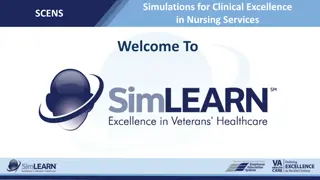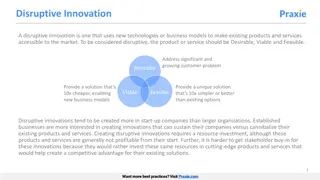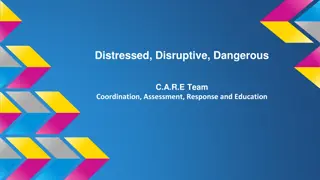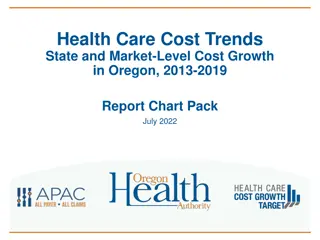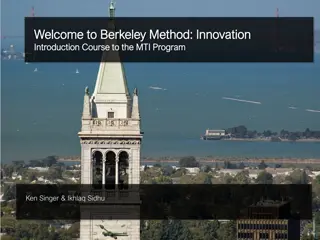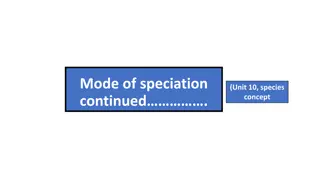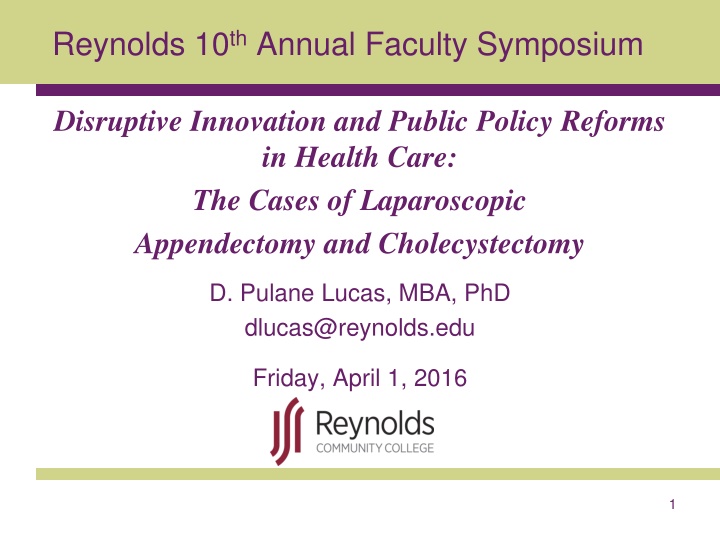
Disruptive Innovation in Health Care: The ALAC Cases
This presentation explores the application of disruptive innovation theory in the health care industry, focusing on ambulatory laparoscopic appendectomy and cholecystectomy procedures. It discusses the effects of disruptive innovation and public policy reforms on these surgical practices, aiming to improve efficiency and quality in the hospital industry.
Download Presentation

Please find below an Image/Link to download the presentation.
The content on the website is provided AS IS for your information and personal use only. It may not be sold, licensed, or shared on other websites without obtaining consent from the author. If you encounter any issues during the download, it is possible that the publisher has removed the file from their server.
You are allowed to download the files provided on this website for personal or commercial use, subject to the condition that they are used lawfully. All files are the property of their respective owners.
The content on the website is provided AS IS for your information and personal use only. It may not be sold, licensed, or shared on other websites without obtaining consent from the author.
E N D
Presentation Transcript
Reynolds 10thAnnual Faculty Symposium Disruptive Innovation and Public Policy Reforms in Health Care: The Cases of Laparoscopic Appendectomy and Cholecystectomy D. Pulane Lucas, MBA, PhD dlucas@reynolds.edu Friday, April 1, 2016 1
Overview of Presentation Introduction Context Purpose of Study Theoretical Framework Methodology Data Analysis Results Discussion Conclusion 2
List of Abbreviations ALAC ALC ALA ACGH Ambulatory Laparoscopic Appendectomy and Cholecystectomy Ambulatory Laparoscopic Cholecystectomy Ambulatory Laparoscopic Appendectomy Acute Care General Hospital ASC Ambulatory Surgery Center CBSA Core-Based Statistical Area CMS Centers for Medicare and Medicaid Services HOPD Hospital Outpatient Department OPD Outpatient Department OPPS Outpatient Prospective Payment System PPS Prospective Payment System 3
Introduction Advances in medical technology Increasing competition in the hospital industry Regulation vs. competition Need for new theoretical frameworks 4
Context Why is it important to explore the applicability of disruptive innovation theory in health care? Increasing competition in the hospital industry Competition should improve efficiency and quality (Porter & Teisberg, 2006) Hospital industry: high costs, poor care, prevalent medical errors (Porter & Teisberg, 2006; Christensen et al., 2009) Calls for regulation Disruptive innovation theory 5
Purpose of Study To examine the effects of disruptive innovation in the health care industry To assess the effects of disruptive innovation and public policy reforms on ambulatory laparoscopic appendectomy and cholecystectomy (ALAC) procedures. 6
Disruptive Innovation Theory Sustaining innovations: high performance, expensive, expertise-intensive products and services; meet needs of most demanding customers in established firms. Disruptive innovations: lower performance products or services on key measures; perform well on other important dimensions valued by new customers in emerging markets (Christensen et al., 2009). 7
Elements of Disruptive Innovation Theory 1. Sophisticated technology that simplifies Regulations and standards that facilitate change 2. Low-cost, innovative business models 3. Economically coherent value networks Source: Christensen et al., 2009: xx. 8
Methodology: Research Design Non-Experimental Panel Study Longitudinal (Retrospective) Repeated Measures Unit of Analysis: The Facility Non-Equivalent Comparison Groups T2004 T2009 ACGHs O1 O3 ASCs O2 O4 (Babbie, 2001; Babbie, 2005) 9
Methodology: Scope of Study Medical Facilities: ASCs and ACGHs Surgery Type: Appendectomy and Cholecystectomy Surgical Procedures: Laparoscopic Surgical Settings: Ambulatory States: Florida and Wisconsin Years: 2004 and 2009 10
Methodology: Hypotheses Hypothesis A: Compared to ACGHs, ASCs will experience a larger percentage increase in the number of ALC performed in 2009 compared to 2004. Hypothesis B: Compared to ACGHs, ASCs will experience a larger percentage increase in the number of ALA performed in 2009 compared to 2004. 11
Methodology: Data and Data Sources Intellimed International, Inc. U.S. Census Bureau 12
Statistical Procedures SPSS Software Univariate Analysis Bivariate Analysis Multivariate Regression Analysis 13
Operationalization of Dependent Variable Dependent Variable Operationalization Hypothesis A: Percent Change in Ambulatory Laparoscopic Cholecystectomy (ALC) (Total 2009 ALC Total 2004 ALC)/ Total 2004 ALC Hypothesis B: Percent Change in Ambulatory Laparoscopic Appendectomy (ALA) (Total 2009 ALA Total 2004 ALA)/Total 2004 ALA 14
Operationalization of Independent Variable Facility Type 0 = Ambulatory Surgery Center (ASC); 1 = Acute Care General Hospital (ACGH) 15
Sample State Medical Facilities Percentage Florida 452 76% Wisconsin 142 24% Total 594 100% A total of 75,216 laparoscopic appendectomy and cholecystectomy procedures were performed in 2004 and 2009. 16
Research Question How has the utilization of ALAC changed over time? 17
Results: Number of Ambulatory Laparoscopic Procedures by State in 2004 and 2009 Procedure Totals by State and Year 30000 24842 25000 19132 20000 Ambulatory Laparoscopic Cholecystectomy Ambulatory Laparoscopic Appendectomy 15000 12225 9599 10000 5000 3239 3083 1677 1419 0 2004 2009 2004 2009 Wisconsin Florida 18
Research Question How do ACGHs and ASCs differ in the utilization of ALAC? 19
Results: Multivariate Regression Analysis Medical Facility Shift (Equation 1) = + + + + + % % AmbLapChol b b ACGH b FLORIDA b POP b METRO 0 1 2 3 4 Represents Percentage Change in Number of ALC Procedures Performed in 2004 and 2009 = Dependent Variable Represent coefficients ALC % Y 0b , 1b , 2b , to nb Facility Type = Independent Variable ACGH State = control variable FLORIDA POP% CBSA population change = control variable CBSA area classification = control variable Represent error term METRO 20
Results: Multivariate Regression Analysis Medical Facility Shift (Equation 2) = + + + + + % % AmbLapApp b b ACGH b FLORIDA b POP b METRO 0 1 2 3 4 Represents Percentage Change in Number of ALC Procedures Performed in 2004 and 2009 = Dependent Variable Represent coefficients ALA % Y 0b , 1b , 2b , to nb Facility Type = Independent Variable ACGH State = control variable FLORIDA POP% CBSA population change = control variable CBSA area classification = control variable Represent error term METRO 21
Results: Multivariate Regression Analysis Facility Type on Percent Change in the Number of Ambulatory Laparoscopic Cholecystectomy Cases Performed in 2004 and 2009 (N = 516) (beta coefficient, beta weight, and significance level) Model 1 Model 2 Model 3 Acute Care General Hospital 2.675** (.000) Florida % Change in CBSA Population Metropolitan Area Constant -.643 (.017) R *P<0.10 **P<0.05 Variables Model 4 3.176** .351 (.000) 3.140** .347 (.000) 3.194** .353 (.000) .296 1.836** .157 (.000) 1.541** .132 (.005) 1.581** .136 (.005) 7.577 .069 (.130) 7.727 .070 (.124) -.298 -.019 (.659) -2.372 (.000) .110 -2.618 (.000) .114 -2.382 (.003) .114 .087 22
Results: Multivariate Regression Analysis Facility Type on Percent Change in the Number of Ambulatory Laparoscopic Appendectomy Cases Performed in 2004 and 2009 ( N = 436) (beta coefficient, beta weight, and significance level) Model 1 Model 2 Model 3 Acute Care General Hospital 3.026** .339 (.000) Florida % Change in CBSA Population Metropolitan Area Constant -.978 (.001) R .115 Variables Model 4 2.306** .258 (.000) 2.294** .257 (.000) 2.331** .261 (.000) -2.515** (.000) -2.691** -.229 (.000) -2.545** -.216 (.000) -.214 4.553 .042 (.381) 4.762 .044 (.360) -.719 -.045 (.337) 1.457 (.018) .154 1.302 (.041) .155 1.840 (.031) .157 23
Results: Summary Hypothesis Chart (mean percent change, beta coefficient, beta weight, and significance) Hypothesis Medical Facility Shift Average % Change ACGH 203% Bivariate Multivariate (Model 4) ASC -64.3% A Compared to ACGHs, ASCs will experience a larger percentage increase in the number of ambulatory laparoscopic cholecystectomy procedures performed. Compared to ACGHs, ASCs will experience a larger percentage increase in the number of ambulatory laparoscopic appendectomy procedures performed. 2.675** .296 (.000) 3.176** .351 (.000) B 205% -97.8% 3.026** .339 (.000) 2.306** .258 (.000) 24
Research Question Do study findings support disruptive innovation theory in the hospital industry? 25
Interpretation of Results: Summary of Hypotheses Hypothesis Hypothesis Supported? No Null Rejected? No A Medical Facility Shift Larger Percent Increase in ALC performed in ASC B Medical Facility Shift Larger Percent Increase in ALA performed in ASC No No 26
Discussion Question Medical Facility: Why did the medical facility shift move contrary to what was expected? 27
Research Question How have public policy reforms affected the provision of ALAC? 28
Discussion: CMS Coverage Determination Appendix E: Partial List of CPT Surgical Procedure Codes Proposed for Exclusion from ASC Facility Fee Payment Because They Require an Overnight Stay, 2006 HCPCS/CPT 42225 42842 42844 43020 43130 43280 43510 44970 47562 60252 63030 Code Short Descriptor Reconstruct cleft palate Extensive surgery of throat Extensive surgery of throat Incision of esophagus Removal of esophagus pouch Laparoscopy, fundoplasty Surgical opening of stomach Laparoscopy, appendectomy Laparoscopic cholecystectomy Removal of thyroid Low back disk surgery Source: CMS. (2007a). 42 CFR Parts 410, 414, 416, 419, 421, 485, and 488. [CMS-1506-P; CMS-4125-P]. Washington, D.C. Department of Health and Human Services. Available online: http://www.cms.gov/Medicare/Medicare-Fee-for-Service- Payment/HospitalOutpatientPPS/downloads/CMS1506P.pdf. 29
Discussion: CMS Coverage Determination HCPCS/CPT 38120 43020 43280 44970 50080 59409 60252 61720 62000 63075 63030 Code Short Descriptor Laparoscopy, splenectomy Incision of esophagus Laparoscopy, fundoplasty Laparoscopy, appendectomy Removal of kidney stone Obstetrical care Removal of thyroid Incise skull/brain surgery Treat skull fracture Neck spine disk surgery Low back disk surgery Appendix F: Partial List of Surgical Procedures Payable under the OPPS That Are Excluded From ASC Payment Because They Pose a Significant Safety Risk or Are Expected to Require an Overnight Stay, 2007 Source: CMS. (2007b). Federal Register Volume 72 Number 148 Thursday, August 2. Rules and Regulations, Pages 42470-42626. http://www.gpo.gov/fdsys/pkg/FR-2007-08-02/html/07- 3490.htm Available online: 30
Ambulatory Laparoscopic Appendectomy in Florida ASC and ACGH Facilities (State-Level) Annual Number of Florida ASC and ACGH Facilities Performing Ambulatory Laparoscopic Appendectomy (2004-2009) and Annual Percent Change Year 2004 2005 2006 2007 2008 2009 Facility Type ASC 233 189 214 8 6 8 ACGH 131 141 142 129 131 131 Total 364 330 356 137 137 139 ASC as a percent of total 64.0% 57.3% 60.1% 5.8% 4.4% 5.8% Data Source: Intellimed, Inc. 31
Ambulatory Laparoscopic Appendectomy in Florida ASC and ACGH Facilities (State-Level) Line Chart: Annual Number of Florida ASCs and ACGHs Performing Ambulatory Laparoscopic Appendectomy Procedures, 2004-2009 250 200 150 ASCs Count ACGHs 100 50 0 2004 2005 2006 2007 2008 2009 Data Source: Intellimed, Inc. 32
Ambulatory Laparoscopic Appendectomy in Wisconsin ASC and ACGH Facilities (State-Level) Annual Number of Wisconsin Facilities Performing Ambulatory Laparoscopic Appendectomy (2004-2009) and Annual Percent Change Year 2004 2005 2006 2007 2008 2009 Facility Type ASC 7 6 10 8 8 6 ACGH 60 60 58 60 64 64 Total 67 66 68 68 72 70 ASC as a percent of total 10.4% 9.1% 14.7% 11.8% 11.1% 8.6% Data Source: Intellimed, Inc. 33
Ambulatory Laparoscopic Appendectomy in Wisconsin in ASC and ACGH Facilities (State-Level) Line Chart: Annual Number of Wisconsin ASCs and ACGHs Performing Laparoscopic Appendectomy Procedures, 2004-2009 70 60 50 40 Count ASCs ACGHs 30 20 10 0 2004 2005 2006 2007 2008 2009 Data Source: Intellimed, Inc. 34
Ambulatory Laparoscopic Cholecystectomy in Florida ASC and ACGH Facilities (State-Level) Annual Number of Florida Facilities Performing Ambulatory Laparoscopic Cholecystectomy (2004-2009) and Annual Percent Change Year 2004 2005 2006 2007 2008 2009 Facility Type ASC 265 233 249 38 42 46 ACGH 164 169 171 158 155 156 Total 429 392 420 196 197 202 ASC as a percent of total 61.8% 56.9% 59.3% 19.4% 21.3% 22.8% Data Source: Intellimed, Inc. 35
Ambulatory Laparoscopic Cholecystectomy in Florida ASC and ACGH Facilities (State-Level) Line Chart: The Number of Florida ASCs and ACGHs Performing Ambulatory Laparoscopic Cholecystectomy Procedures, 2004-2009 300 250 200 Count ASCs 150 ACGHs 100 50 0 2004 2005 2006 2007 2008 2009 Data Source: Intellimed, Inc. 36
Ambulatory Laparoscopic Cholecystectomy in Wisconsin ASC and ACGH Facilities (State-Level) Annual Wisconsin Totals for Laparoscopic Cholecystectomy Procedures Performed in ASCs and ACGHs, 2004-2009 Year 2004 2005 2006 2007 2008 2009 Facility Type ASC 16 16 16 17 15 18 ACGH 67 64 65 64 65 66 Total 83 80 81 81 80 84 ASC as a percent of total 19.3% 20.0% 19.8% 21.0% 18.8% 21.40% Data Source: Intellimed, Inc. 37
Ambulatory Laparoscopic Cholecystectomy in Wisconsin (State-Level) Line Chart: Wisconsin ASCs and ACGHs Performing Ambulatory Laparoscopic Cholecystectomy Procedures, 2004-2009 80 70 60 50 Count ASCs 40 ACGHs 30 20 10 0 2004 2005 2006 2007 2008 2009 Data Source: Intellimed, Inc. 38
Discussion: Medicare Fee-For-Service Payment Rates Laparoscopic Appendectomy and Laparoscopic Cholecystectomy for Hospital Outpatient Prospective Payment System (PPS) Percent change between 2004 and 2009 HCPCS Code 44970 Relative Weight Payment Rate Year 2004 Descriptor Laparoscopy Appendectomy Laparoscopy Appendectomy Laparoscopic Cholecystectomy Laparoscopic Cholecystectomy 32.7724 $1,788.09 71.1% 2009 44970 46.3238 $3,060.10 2004 47562 40.8064 $2,226.44 37.4% 2009 47562 46.3238 $3,060.10 39
Conclusion The hospital industry is one of the most dynamic marketplaces in the U.S. economy. With health care spending rising and competition intensifying, new and revised theoretical frameworks are needed to understand better the interplay between technology, organizations, and regulation. advanced medical 40
Questions and Discussion Thank you for your time. 41
References Books & Articles American College of Surgeons. Cholecystectomy. Patient education website. Available online: http://www.facs.org/public_info/operation/cholesys.pdf. Babbie, E. (2001). The practice of social research. Belmont, CA. Thomson Wadsworth. Babbie, E. (2005). The basics of social research. Belmont, CA. Thomson Wadsworth. Baum, J. A. C., & Shipilov. (2004). Ecological approaches to organizations. In Stewart R. Clegg, Cynthia Hardy, Tom Lawrence, and Walter Nord (eds.), Handbook of Organizations Studies (2e): 55-110. London: Sage Publications. Campbell, D. T., & Stanley, J. C. (1963). Experimental and quasi-experimental designs for research. Boston, MA. Houghton Mifflin Company. Christensen, C. M., Grossman, J. H., & Hwang, J. (2009). The innovator s prescription: A disruptive solution for health care. New York. McGraw-Hill. Danneels, E. (2004). Disruptive technology reconsidered: A critique and research agenda. Journal of Product Innovation Management, 21(4), 246-258. DiMaggio, P. J. & Powell, W. W. (2004). The iron cage revisited: Institutional isomorphism and collective rationality in organization fields. In Dobbin, F. (ed.) The New Economic Sociology, Princeton. Princeton University Press. (Chapter 4, 111-134). 42
References (Continued) Books & Articles Encinosa, W. E., Bernard, D. M., Steiner, C. A., & Chen, C. (2005). Use and costs of bariatric surgery and prescription weight-loss medications. Health Affairs, 24(4), 1039-1046. Govindarajan, V., Kopalle, P. K. (2006). The usefulness of measuring disruptiveness of innovations ex post in making ex ante predictions. Journal of Product Innovation Management, 23, 12-18. Hannan, M. T. & Freeman, J. (1977). The population ecology of organizations. The American Journal of Sociology, 82(5), 929-964. Hume, D. J. & Simpson, J. (2006). Acute Appendicitis. British Medical Journal, 333, 530- 534. Lucas, D. P. (2014). Disruptive Transformations in Health Care: The Impact of Technological Innovation and Public Policy in the Hospital Industry. Saarbr cken, Deutschland/Germany. Lambert Academic Publishing. Lucas, D. P. (2015). Disruptive Transformations in Health Care: Technological Innovation and Public Policy Reforms in the Hospital Industry in The International Journal of Interdisciplinary Organizational Studies, Volume 9, Issue 1. 43
References (Continued) Books & Articles Porter, M. E. (1979). How competitive forces shape strategy. Harvard Business Review. March/April. Porter, M.E. (1980). Competitive Strategy. New York. Free Press. Porter, M. E. & Teisberg, E. O. (2006). Redefining heath care: Creating value-based competition on results. Boston, MA. Harvard Business School Press. Rapoport, J., Chaulk, P., Kuropatwa, R., & Wright, M. (2011). Game changing or disruptive innovation: Analytical framework and background study. Institute of Health Economics. Alberta, Canada. Available online: http://www.ihe.ca/documents/2011%2002%2023%20IHE%20Disruptive%20Innovations%2 0Paper%20FINAL.pdf. Scott, W. R., Ruef, M., Mendel, P. J., & Caronna, C. A. (2000). Institutional change and healthcare organization. Chicago, IL. The University of Chicago Press. Tellis, G. J. (2006). Disruptive technology or visionary leadership? Journal of Product Innovation Management, 23, 34-38. Yu, D., & Hang, C. C. (2010). A reflective review of disruptive innovation theory. International Journal of Management Review, 12(4), 435-452. 44



